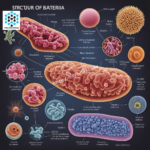Differences Between Prokaryotic and Eukaryotic Cells
Today, we are going to explore the similarities and differences between Prokaryotic vs Eukaryotic cells.
All living organisms are composed of cells, which are classified into two main categories: Prokaryotic vs Eukaryotic Prokaryotes include bacteria and archaea, while eukaryotes encompass plants, animals, fungi, and all other organisms.
Defining Prokaryotic and Eukaryotic Cells
The primary distinction between prokaryotic and eukaryotic cells lies in the presence of a nucleus. Eukaryotic cells have their genetic material enclosed within a nuclear envelope, forming a definite nucleus.
This characteristic is exemplified in animal cells, where the nucleus serves as the command center of the cell, containing the DNA. In contrast, prokaryotic cells lack a nuclear membrane.
Instead, their DNA resides in the cytoplasm, within a region called the nucleoid. Unlike a true nucleus, the nucleoid is not a distinct structure but merely an area where the DNA is concentrated.
Evolution and Prevalence
Prokaryotes are the earliest forms of life on Earth, having evolved billions of years ago. They remain the most common organisms today.
It is widely believed that eukaryotic cells evolved from prokaryotic ancestors. This evolutionary leap introduced complex cellular structures and processes that distinguish eukaryotes from their prokaryotic counterparts.
Cellular Organelles
Another significant difference between these two cell types is the presence of organelles. Organelles are specialized structures within the cytoplasm that perform specific functions essential to the cell’s survival and efficiency.
Eukaryotic cells boast a variety of organelles, including mitochondria (the cell’s powerhouse), endoplasmic reticulum, Golgi apparatus, and lysosomes, among others. These organelles compartmentalize cellular functions, allowing eukaryotes to maintain a higher level of organization and complexity.
In contrast, prokaryotic cells have a much simpler structure. Ribosomes, which are responsible for protein synthesis, are the only organelles found in prokaryotic cells. Despite their simplicity, prokaryotes thrive in diverse environments due to their small size and streamlined cellular processes.
Size and Efficiency
Eukaryotic cells, although still microscopic, are significantly larger than prokaryotic cells.
This size difference is due to the presence of multiple organelles and the complex internal structure of eukaryotic cells. The larger size allows for greater cellular specialization and the ability to form multicellular organisms.
However, being smaller and simpler offers distinct advantages to prokaryotes. Their small size results in a large surface area-to-volume ratio, enabling efficient nutrient uptake and waste removal.
This efficiency allows prokaryotes to grow rapidly and reproduce quickly, adapting to various environmental conditions with ease.
Unicellularity vs. Multicellularity
A key point of distinction is that all prokaryotes are unicellular organisms, meaning they consist of a single cell. Eukaryotes, on the other hand, can be either unicellular or multicellular.
While prokaryotes are traditionally viewed as solitary cells, recent research suggests that some bacterial species can form colonies and exhibit division of labor, a trait characteristic of multicellular organisms.
Despite this, there is considerable debate and resistance to classifying any prokaryote as truly multicellular.
Conclusion
In summary, the fundamental differences between prokaryotic and eukaryotic cells revolve around the presence of a nucleus, the complexity of cellular organelles, and the size and organizational structure of the cells.
Prokaryotes, with their simple, efficient design, continue to dominate in sheer numbers and adaptability. Eukaryotes, with their complex and compartmentalized cells, have given rise to the vast diversity of life forms we observe today.
Understanding these distinctions not only highlights the beauty of cellular evolution but also underscores the incredible adaptability of life on Earth.
FAQs: Prokaryotic and Eukaryotic Cells
1. What are the main differences between prokaryotic and eukaryotic cells?
The main differences are:
- Nucleus: Eukaryotic cells have a nucleus enclosed by a nuclear membrane, while prokaryotic cells do not. The genetic material in prokaryotic cells is located in a region called the nucleoid.
- Organelles: Eukaryotic cells contain various organelles (e.g., mitochondria, endoplasmic reticulum) that compartmentalize cellular functions. Prokaryotic cells have few organelles, with ribosomes being the primary one.
- Size: Eukaryotic cells are generally larger than prokaryotic cells.
- Complexity: Eukaryotic cells are more complex in structure and function compared to the simpler prokaryotic cells.
2. What organisms are prokaryotes?
Prokaryotes include bacteria and archaea. These organisms are unicellular and lack a membrane-bound nucleus and other complex organelles.
3. What organisms are eukaryotes?
Eukaryotes include plants, animals, fungi, and all other organisms that have cells with a nucleus enclosed by a nuclear membrane. These organisms can be either unicellular or multicellular.
4. Do prokaryotic cells have any organelles?
Yes, prokaryotic cells have ribosomes, which are responsible for protein synthesis. However, they lack other membrane-bound organelles found in eukaryotic cells.
5. How did eukaryotic cells evolve?
It is believed that eukaryotic cells evolved from prokaryotic ancestors through a process that involved the development of internal membranes and the incorporation of certain prokaryotes into larger cells, leading to the formation of organelles like mitochondria and chloroplasts.
6. Why are eukaryotic cells larger than prokaryotic cells?
Eukaryotic cells are larger because they contain multiple organelles that perform specific functions, allowing for greater cellular specialization and complexity. This larger size and compartmentalization facilitate more efficient functioning and organization.
7. Can prokaryotic cells form multicellular organisms?
Prokaryotic cells are traditionally considered unicellular. However, some bacterial species can aggregate and form colonies, exhibiting division of labor, which is a multicellular characteristic.
Despite this, there is debate about classifying these colonies as truly multicellular.
8. What advantages do prokaryotic cells have due to their small size?
Prokaryotic cells have a high surface area-to-volume ratio, which allows for efficient nutrient uptake and waste removal.
Their small size and simplicity enable rapid growth and reproduction, making them highly adaptable to various environments.
9. What are ribosomes, and why are they important?
Ribosomes are small structures within cells that are responsible for synthesizing proteins by translating genetic information. They are essential for cell function because proteins are crucial for virtually all cellular processes.
10. How do organelles benefit eukaryotic cells?
Organelles allow eukaryotic cells to compartmentalize different functions, leading to increased efficiency and specialization.
For example, mitochondria generate energy, the endoplasmic reticulum synthesizes proteins and lipids, and lysosomes break down waste materials.
Feel free to reach out with any more questions you may have about prokaryotic and eukaryotic cells!


